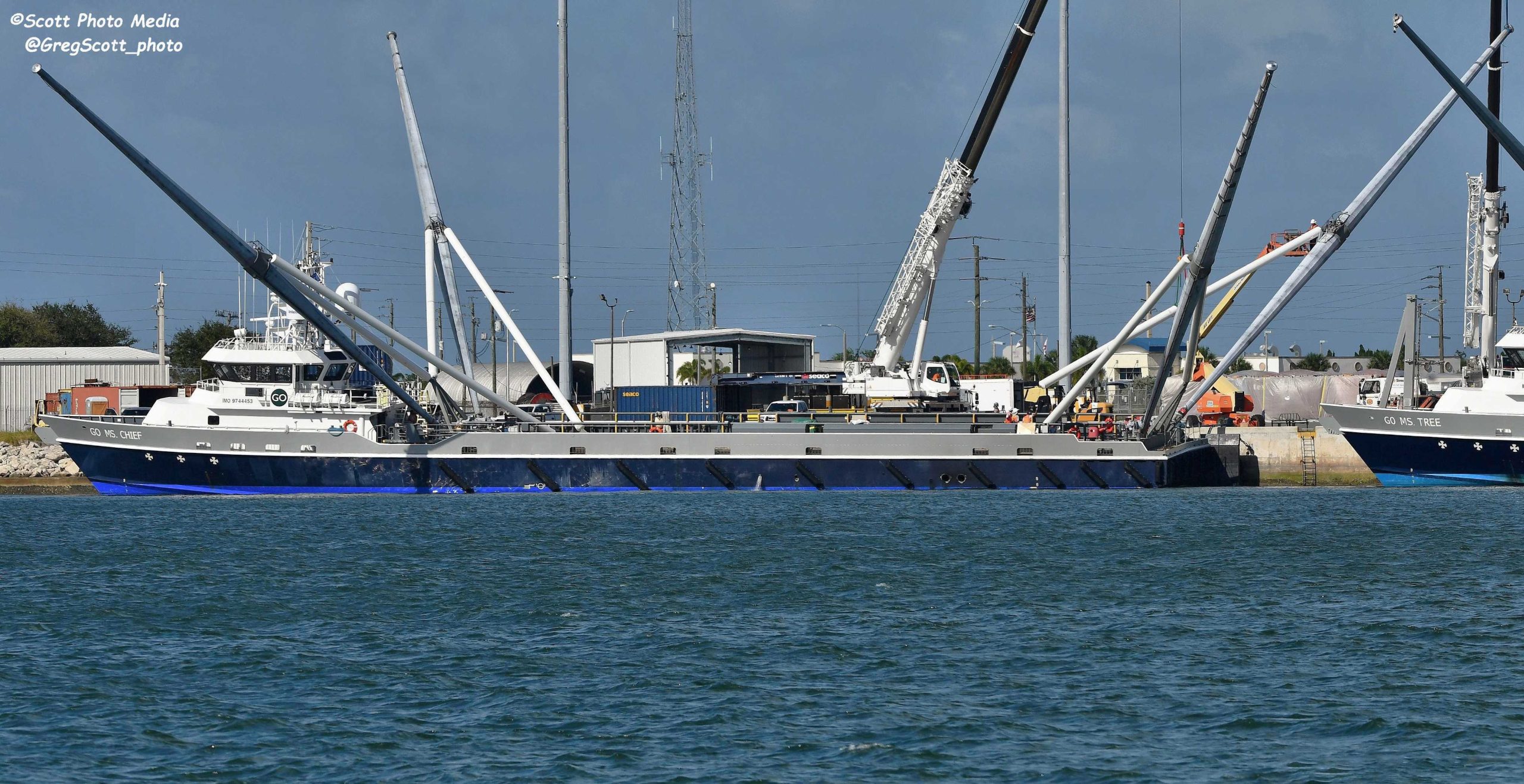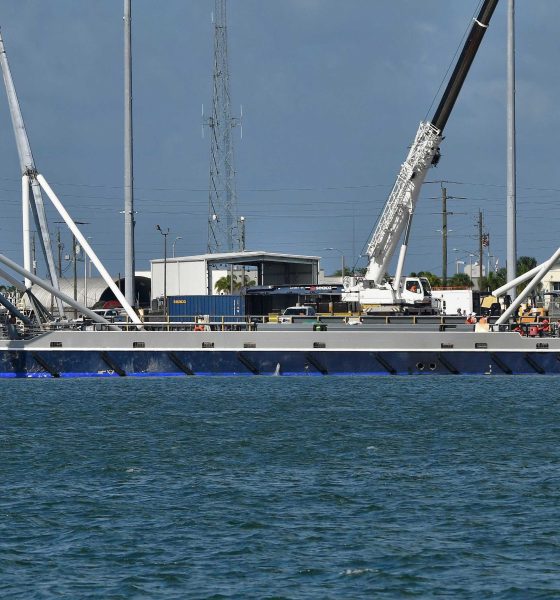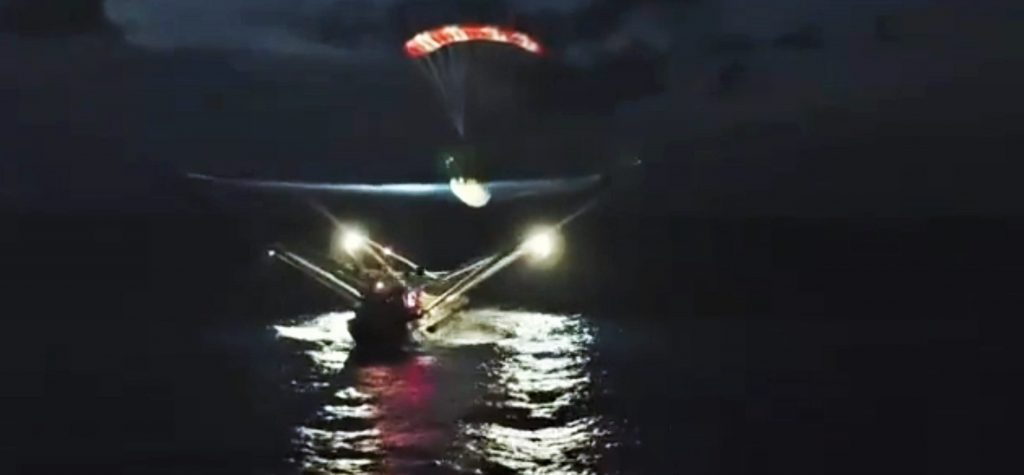

News
SpaceX to catch two Falcon 9 fairings at once with twin nets
Over the last three or so weeks, SpaceX rocket recovery technicians and engineers have rapidly modified a second Falcon fairing recovery vessel – known as GO Ms. Chief – to the point that it appears to be almost ready for its first catch attempt.
Essentially a twin of GO Ms. Tree (formerly Mr. Steven), Ms. Chief now features four arms – each with two white support beams – that hold two massive, retractable nets. Ultimately, SpaceX has augmented Ms. Tree with Ms. Chief in a bid to simultaneously catch both parasailing halves of a Falcon 9 (or Heavy) payload fairing after any given launch, the Holy Grail of the company’s fairing recovery program.
A few days after the above photos were taken, SpaceX successfully installed Ms. Chief’s fairing-catching nets and has since taken the ship a few miles beyond Port Canaveral limits for sea trails – presumably meant to verify center of gravity and other performance characteristics. This may or may not have included tests of the newly-modified ship’s fairing recovery mechanism, referring to what is understood to be a direct link between fairing and ship designed to autonomously guide both to the right position for a catch.
Ensuring that that new hardware and software is in good working order is probably even more important than installing Ms. Chief’s arms and nets, evidenced by the fact that it took SpaceX more than 16 months and five failed attempts before Mr. Steven (now Ms. Tree) successfully caught its first fairing. The first success came on June 25th after Falcon Heavy’s third successful launch.

In an encouraging sign, SpaceX’s very next launch (with a fairing) – Falcon 9’s August 6th AMOS-17 mission – marked the second successful fairing catch ever, suggesting that the breakthrough(s) that enabled that first success may be broadly applicable. SpaceX’s next launch with a payload fairing should essentially confirm whether the company’s fairing recovery program has truly reached the end of the tunnel or if there is some distance still to go.
Since AMOS-17, however, SpaceX has been in the midst of a period of launch inactivity unprecedented since Falcon 9’s catastrophic Amos-6 failure in September 2016, triggering a fleet-grounding that lasted four months. That lull has undoubtedly given SpaceX’s recovery team plenty of time to outfit Ms. Chief and perform shakedowns of the vessel’s new hardware, but it also means that there have been zero opportunities for additional fairing-recovery data gathering.
Mystery and mischief are waiting for it. pic.twitter.com/akgqg29nQf— Marek Cyzio (@MarekCyzio) October 6, 2019
According to publicly-available launch manifests, SpaceX no longer has firm dates for its next launch(es). Previously expected to be one or even two Starlink launches, those missions are now scheduled to launch sometime in October or November. The Kacific-1 communications satellite currently has a (fairly) firm launch target of November 11th, making the mission the best possible bet for SpaceX’s next launch – at least for the time being.
On the plus side, regardless of when SpaceX is able to break its now two-month-long launch hiatus, it appears extremely likely that said launch will become the first attempt at simultaneously catching both Falcon fairing halves. If successful, it could quite rapidly pave the way towards fast, low-cost fairing reuse, a necessity for the economic deployment of SpaceX’s Starlink satellite internet constellation.
Check out Teslarati’s Marketplace! We offer Tesla accessories, including for the Tesla Cybertruck and Tesla Model 3.

Elon Musk
Elon Musk’s X will start using a Tesla-like software update strategy
The initiative seems designed to accelerate updates to the social media platform, while maintaining maximum transparency.

Elon Musk’s social media platform X will adopt a Tesla-esque approach to software updates for its algorithm.
The initiative seems designed to accelerate updates to the social media platform, while maintaining maximum transparency.
X’s updates to its updates
As per Musk in a post on X, the social media company will be making a new algorithm to determine what organic and advertising posts are recommended to users. These updates would then be repeated every four weeks.
“We will make the new 𝕏 algorithm, including all code used to determine what organic and advertising posts are recommended to users, open source in 7 days. This will be repeated every 4 weeks, with comprehensive developer notes, to help you understand what changed,” Musk wrote in his post.
The initiative somewhat mirrors Tesla’s over-the-air update model, where vehicle software is regularly refined and pushed to users with detailed release notes. This should allow users to better understand the details of X’s every update and foster a healthy feedback loop for the social media platform.
xAI and X
X, formerly Twitter, has been acquired by Elon Musk’s artificial intelligence startup, xAI last year. Since then, xAI has seen a rapid rise in valuation. Following the company’s the company’s upsized $20 billion Series E funding round, estimates now suggest that xAI is worth tens about $230 to $235 billion. That’s several times larger than Tesla when Elon Musk received his controversial 2018 CEO Performance Award.
As per xAI, the Series E funding round attracted a diverse group of investors, including Valor Equity Partners, Stepstone Group, Fidelity Management & Research Company, Qatar Investment Authority, MGX, and Baron Capital Group, among others. Strategic partners NVIDIA and Cisco Investments also continued support for building the world’s largest GPU clusters.
News
Tesla FSD Supervised wins MotorTrend’s Best Driver Assistance Award
The decision marks a notable reversal for the publication from prior years, with judges citing major real-world improvements that pushed Tesla’s latest FSD software ahead of every competing ADAS system.

Tesla’s Full Self-Driving (Supervised) system has been named the best driver-assistance technology on the market, earning top honors at the 2026 MotorTrend Best Tech Awards.
The decision marks a notable reversal for the publication from prior years, with judges citing major real-world improvements that pushed Tesla’s latest FSD software ahead of every competing ADAS system. And it wasn’t even close.
MotorTrend reverses course
MotorTrend awarded Tesla FSD (Supervised) its 2026 Best Tech Driver Assistance title after extensive testing of the latest v14 software. The publication acknowledged that it had previously criticized earlier versions of FSD for erratic behavior and near-miss incidents, ultimately favoring rivals such as GM’s Super Cruise in earlier evaluations.
According to MotorTrend, the newest iteration of FSD resolved many of those shortcomings. Testers said v14 showed far smoother behavior in complex urban scenarios, including unprotected left turns, traffic circles, emergency vehicles, and dense city streets. While the system still requires constant driver supervision, judges concluded that no other advanced driver-assistance system currently matches its breadth of capability.
Unlike rival systems that rely on combinations of cameras, radar, lidar, and mapped highways, Tesla’s FSD operates using a camera-only approach and is capable of driving on city streets, rural roads, and freeways. MotorTrend stated that pure utility, the ability to handle nearly all road types, ultimately separated FSD from competitors like Ford BlueCruise, GM Super Cruise, and BMW’s Highway Assistant.
High cost and high capability
MotorTrend also addressed FSD’s pricing, which remains significantly higher than rival systems. Tesla currently charges $8,000 for a one-time purchase or $99 per month for a subscription, compared with far lower upfront and subscription costs from other automakers. The publication noted that the premium is justified given FSD’s unmatched scope and continuous software evolution.
Safety remained a central focus of the evaluation. While testers reported collision-free operation over thousands of miles, they noted ongoing concerns around FSD’s configurable driving modes, including options that allow aggressive driving and speeds beyond posted limits. MotorTrend emphasized that, like all Level 2 systems, FSD still depends on a fully attentive human driver at all times.
Despite those caveats, the publication concluded that Tesla’s rapid software progress fundamentally reshaped the competitive landscape. For drivers seeking the most capable hands-on driver-assistance system available today, MotorTrend concluded Tesla FSD (Supervised) now stands alone at the top.
News
Elon Musk’s Grokipedia surges to 5.6M articles, almost 79% of English Wikipedia
The explosive growth marks a major milestone for the AI-powered online encyclopedia, which was launched by Elon Musk’s xAI just months ago.

Elon Musk’s Grokipedia has grown to an impressive 5,615,201 articles as of today, closing in on 79% of the English Wikipedia’s current total of 7,119,376 articles.
The explosive growth marks a major milestone for the AI-powered online encyclopedia, which was launched by Elon Musk’s xAI just months ago. Needless to say, it would only be a matter of time before Grokipedia exceeds English Wikipedia in sheer volume.
Grokipedia’s rapid growth
xAI’s vision for Grokipedia emphasizes neutrality, while Grok’s reasoning capabilities allow for fast drafting and fact-checking. When Elon Musk announced the initiative in late September 2025, he noted that Grokipedia would be an improvement to Wikipedia because it would be designed to avoid bias.
At the time, Musk noted that Grokipedia “is a necessary step towards the xAI goal of understanding the Universe.”
Grokipedia was launched in late October, and while xAI was careful to list it only as Version 0.1 at the time, the online encyclopedia immediately earned praise. Wikipedia co-founder Larry Sanger highlighted the project’s innovative approach, noting how it leverages AI to fill knowledge gaps and enable rapid updates. Netizens also observed how Grokipedia tends to present articles in a more objective manner compared to Wikipedia, which is edited by humans.
Elon Musk’s ambitious plans
With 5,615,201 total articles, Grokipedia has now grown to almost 79% of English Wikipedia’s article base. This is incredibly quick, though Grokipedia remains text-only for now. xAI, for its part, has now updated the online encyclopedia’s iteration to v0.2.
Elon Musk has shared bold ideas for Grokipedia, including sending a record of the entire knowledge base to space as part of xAI’s mission to preserve and expand human understanding. At some point, Musk stated that Grokipedia will be renamed to Encyclopedia Galactica, and it will be sent to the cosmos.
“When Grokipedia is good enough (long way to go), we will change the name to Encyclopedia Galactica. It will be an open source distillation of all knowledge, including audio, images and video. Join xAI to help build the sci-fi version of the Library of Alexandria!” Musk wrote, adding in a later post that “Copies will be etched in stone and sent to the Moon, Mars and beyond. This time, it will not be lost.”








